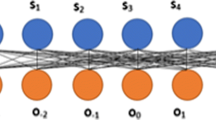Abstract
Because the expert(s) usually give the judgment with an uncertainty degree in general decision-making problems, combined the analytic hierarchy process (AHP) with the basic theory of the triangular fuzzy number (TFN), a TFN-based AHP model is suggested. The proposed model makes decision-makers’ judgment more accordant with human thought mode and derives priorities from TFN-based judgment matrices regardless of their consistency. In addition, formulas of the model are normative, they can be operated by programming easily and no human intervention is needed while applying the model-based software system. The results of an illustrative case indicate that, by applying the proposed model, fair and reasonable conclusions are obtained and the deviation scope of the priority weight of every decision element is given easily.
Preview
Unable to display preview. Download preview PDF.
Similar content being viewed by others
References
Saaty, T.L.: The Analytic Hierarchy Process. McGraw-Hill, New York (1980)
Saaty, T.L.: How to Make a Decision: The AHP. European Journal of Operational Research 48, 9–26 (1990)
Millet, I., Satty, T.L.: On the Relativity of Relative Measures – Accommodating Both Rank Preservation and Rank Reversals in the AHP. European Journal of Operational Research 121, 205–212 (2000)
Chang, D.Y.: Application of the Extent Analysis Method on Fuzzy AHP. European Journal of Operational Research 95, 649–655 (1996)
Zhu, K.J., Yu, J.: A Discussion on Extent Analysis Method and Applications of Fuzzy AHP. European Journal of Operational Research 116, 450–456 (1999)
Kaufmamm, A., Gupta, M.M.: Introduction to Fuzzy Arithmetic Theory and Applications. Van Nostrand Reinhold, New York (1991)
Dubois, D., Prade, H.: Fuzzy Sets and Systems: Theory and Applications. Academic Press, New York (1980)
Yu, C.S.: A GP-AHP Method for Solving Group Decision-making Fuzzy AHP Problems. Computer & Operation Research 29, 1969–2001 (2002)
Grawford, G., Williams, C.A.: A Note on the Analysis of Subjective Judgment Matrices. Journal of Mathematical Psychology 29, 387–405 (1985)
Kwiesielewicz, M., Uden, E.V.: An Additional Result of Monsuur’s Paper about Intrinsic Consistency Threshold for Reciprocal Matrices. European Journal of Operational Research 140, 88–92 (2002)
Author information
Authors and Affiliations
Editor information
Editors and Affiliations
Rights and permissions
Copyright information
© 2005 Springer-Verlag Berlin Heidelberg
About this paper
Cite this paper
Cao, J., Zhou, G., Ye, F. (2005). A TFN-Based AHP Model for Solving Group Decision-Making Problems. In: Hao, Y., et al. Computational Intelligence and Security. CIS 2005. Lecture Notes in Computer Science(), vol 3801. Springer, Berlin, Heidelberg. https://doi.org/10.1007/11596448_17
Download citation
DOI: https://doi.org/10.1007/11596448_17
Publisher Name: Springer, Berlin, Heidelberg
Print ISBN: 978-3-540-30818-8
Online ISBN: 978-3-540-31599-5
eBook Packages: Computer ScienceComputer Science (R0)




